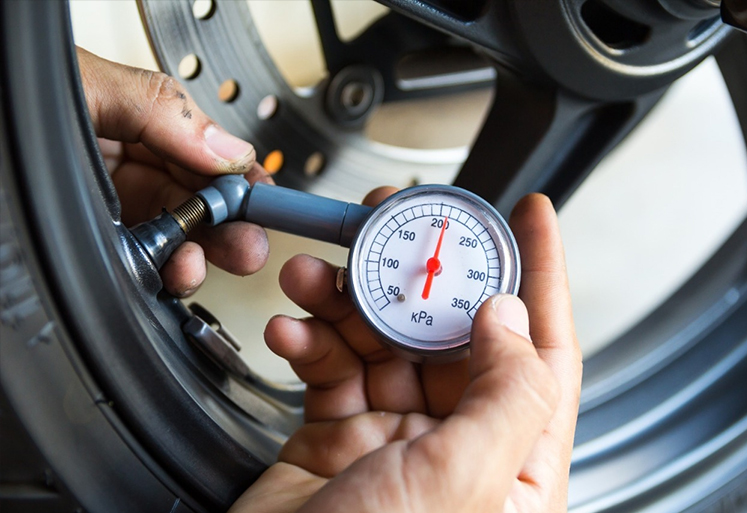Automobiles run smoothly when their tires are properly inflated. Every vehicle tire has its manufacturer-recommended air pressure level. However, it’s pretty easy to exceed this level in your quest to achieving better driving comfort and fuel efficiency. But does overinflated tires improve your vehicle’s efficiency?
Not at all. Excess air in your tires can cause a number of problems. In this article, we discuss how to check your tire pressure and remove the excess air in it.
How to Check Your Tire Pressure
Every car owner needs to keep some important tools in their glove compartment. One of these must-have tools is a digital tire gauge. It’s a smart way to tell that your tire is going flat and you need to inflate it. You may also want to write down the fuel economy and the tire pressure in a notebook.
Here are a few signs that indicate your tire is going flat:
- Excessive Vibration. When your car tires are going flat, it may cause the steering wheel to shake.
- Bulging or Blistering Spots
- Low Pressure
- Worn out tread
You need to know how to check your tire pressure so your car will keep running smoothly. It’s pretty easy with the steps listed below.
Step 1:
Find out your tire’s recommended pressure level. This information is usually found in the doorjamb on the driver’s side or in the manual.
Step 2:
Check the tire pressure. It’s best to do this when the tires are cool.
Step 3:
Take out the valve cap and place it in a place where you can quickly locate it
Step 4:
Press the tire gauge onto the valve stem. You will see a reading on the device’s digital screen. Keep the tire gauge pressed onto the valve stem for about two seconds to ensure that the reading is accurate.
Step 5:
Rotate the valve stem cap clockwise to attach it.
What will happen if the tire pressure is too much?

It’s wise to keep your tire pressure at manufacturer-recommended levels because high pressure could result in some issues. For instance, when you overinflate your tire, it can round out on the tread section. When this happens, the tire will start wearing out prematurely. That means your tire will not live up to its lifespan.
Another issue that could arise from an overinflated tire is traction loss. It doesn’t matter how perfect the roads you drive on are. Overly inflated tires are notorious culprits of traction loss, and this can cause accidents. This issue is even worse during the winter, so it would be best if you checked your tire pressure properly.
How Do I Deflate a Tire?
As mentioned earlier excess air in tires causes a number of issues. Your car will have a hard time maintaining proper grip with the ground surface. Also, overinflation will cause it to lose traction on regular roads.
Luckily, you can easily maintain the air pressure levels and avoid accidents. All you need to do is ensure that the amount of air pressure in your tires are perfect. Let’s take a quick look at the processes involved in letting out air from a tire.
Step 1: Locate the Valve Stem
You can inflate or deflate the air in tires through their valve stem. The stem protrudes from the tire’s rim and is connected to the tube. Locate it and remove its cap in an anticlockwise direction.
Step 2: Press the Valve Pin
Once you remove the valve stem cap, you will see a metal pin in the center of the stem. Use a flat-head screwdriver to press the pin inward. At this point, air will start releasing from your tire through the valve stem.
Step 3: Check the tire pressure
Remove the screwdriver from the valve stem and use a pressure gauge to check the tire pressure. Do this periodically until you reach the recommended air pressure level.
Conclusion
Automobile tires require a manufacturer-recommended amount of air pressure level to operate smoothly. Adding excess air to your tire can result in traction loss and premature wear, which lowers its lifespan. Luckily, you can easily check your tire’s air pressure level with a pressure gauge. With the steps listed above, you’ll be able to maintain your tires and have them running smoothly.
FAQ
Why do my tires lose air so fast?
Your tires may lose air for a variety of reasons. It could be a hole in the sidewall or the tread from an encounter with a sharp object on the road. Air may also escape from a tire if there’s a poor seal where it attaches to the wheel.
Why won’t my tires take air?
If your tires can’t take air when you try to inflate it, maybe dry grass or small gravel stones are stuck between the wheel and the tire. When this happens, pressurized air inside your tire will escape through the leak.


What is the ideal type pressure for Toyota vitz ? (YOM – 2017)
may we know the tire size please?